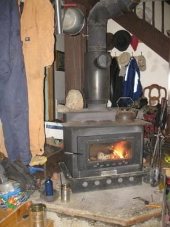I apologise for my extreme ignorance in advance, but am hoping for any practical advice on a big Dutchwest 2479 woodstove (that has a 152mm flue-exit/flue-collar diameter) to connect to 106mm stovepipe with an adapter, venting to an existing outside chimney, which is has a diameter of about 180mm. The stove was a
gift, and very limited finances mean that everything is DIY with used, recycled, reclaimed materials. We live in the countryside of northern Japan, where kerosene stoves are commonly used with 106mm stovepipe connected to an outside chimney. The chimney is on the windward side of a two-storey house, looks to be
concrete enclosing a ceramic chimney, with access for cleaning from a small outside gate at a height of about 60cm or so.
One of the issues is that the hole in the wall where the stovepipe connects to the chimney is 106mm - much smaller than the Dutchwest 152mm. Rather than increasing the diameter of that hole in the wall, we would like to use single-wall 106mm stovepipe. What are the risks of using a much smaller stovepipe for a big stove? We might insulate the 106mm stovepipe ourselves, as a
local friend has done successfully, and someone on this site also posted about that.
Another issue is that the
water mains are right out in the kitchen, just below the chimney connection point. People don't heat empty houses here, and turn their
heaters off at night, so if they're going to go away for more than a day, or it's going to be an extremely cold night, they turn off the water at the mains and drain the pipes. The lever to turn off the water is about 90cm in height. The water pipe to supply the bathroom goes up the wall, near the stovepipe. There is only 170mm clearance to some plastic parts on the plumbing to the right, 315mm to a wooden cupboard to the left, and only 295mm between the current 106mm-diameter stovepipe and the ceiling. What kind of heat shield, if any, would work in this small space - for the ceiling and all three sides?
Another issue is that the horizontal run of the stovepipe would be 1800mm or so, after an initial vertical of 1200mm. That would involve two 90-degree bends, plus a 45-degree joint in between because the chimney is in the corner of the room and the stove is in the middle.
The current chimney also vents a kerosene hot-water boiler in an unheated area on the other side of an uninsulated wall, connected with a T. Potential problems of draft & toxic fumes mean we might have to find a new way to vent the hot-water boiler without using the current chimney, although some local knowledge says that this type of outside chimney can work really well for woodstoves, so draft might not be a problem. Would lighting some
newspaper from the outside cleaning gate help warm up the chimney to create draft, if it seems to be an issue?
The stove just got put in the house yesterday, in the middle of the kitchen. There's
enough firewood for evening use for four to five months, but the stove won't be firing most of the time and the chimney will definitely cool down. Very rarely, temperatures can go as low as -20C, but it's usually -5 to -10C. The incredible amount of snowfall provides an insulating layer on the ground, so the frost level is only 60cm, and the snow accumulation blocks the little gaps in the foundations of this drafty, poorly insulated house.
The top down fire-starting method (also first lighting lots of loosely bundled newspaper on top to try to warm up the chimney) seems like it might help improve draft.
We're going to give it a go and be prepared to call it off & just rely on the kerosene heater with warm baths to warm up (Japanese style) before going to bed with a
hot water bottle, but any quick constructive responses with suggestions to make it work would be greatly appreciated! Thanks to any of you who actually read through all of this!





 1
1




 1
1









 1
1




 1
1




 2
2




















